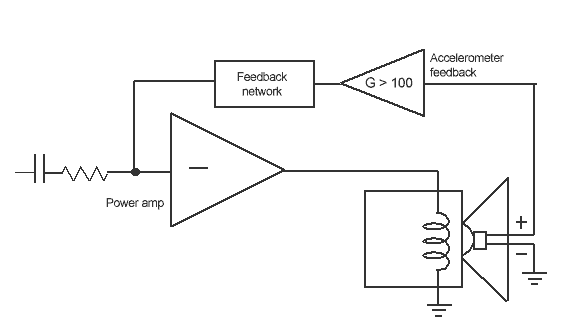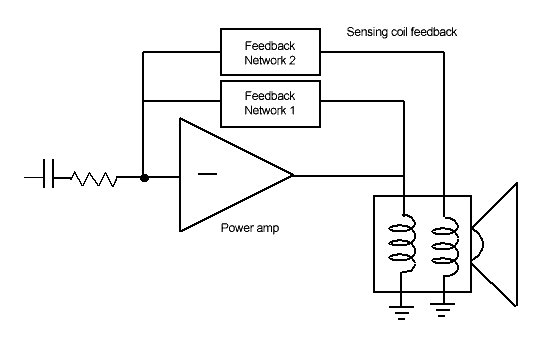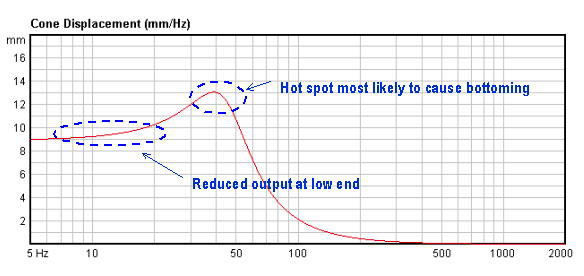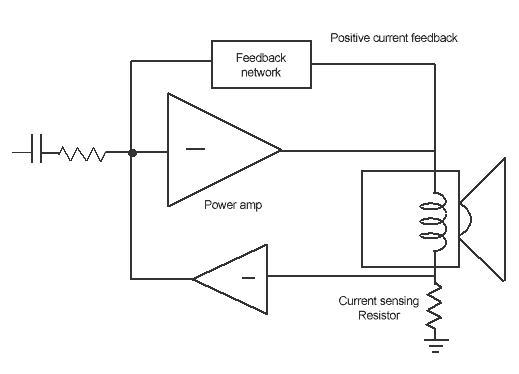Servo controlled subwoofers are not new. There are a number of different systems that have been used for some time, with varying degrees of success. Other servo technologies range from poor to moderately successful, but none of them can match the accuracy of Direct Servo.
1. Accelerometer based
Accelerometer based servos place use a device which measures cone excursion to create a feedback signal.

In this type of servo system, the feedback from the accelerometer needs to be amplified by a factor of at least 100. Therefore it is very common for these subs to exhibit so-called servo noise (hiss).
Another problem is the material at the heart of accelerometer, which is piezo, does not react directly to velocity. Instead, it reacts to "deformation". Therefore, it needs a mechanical assembly to concert "acceleration" to linear amount of "deformation". It is most commonly implemented with a mass attached to a piezo film. As the accelerometer moves with the voice coil, the mass will press against the piezo film and generate an acceleration signal.
There are other issues for accelerometers used in speakers. Any variation of air pressure inside the enclosure can act on the casing of the accelerometer and create a false acceleration signal. This can lead to an unwanted parasitic effect. Another problem is that accelerometers can pick up acceleration information in all three axes. However, because the cone can only move in one direction and only be corrected in one direction, picking up acceleration in the other two directions can lead to incorrect feedback. Therefore, although they produce low distortion on paper, the dynamic sense of the music from these subwoofers is normally not as good as the best non-servo subwoofers.
Another disadvantage of accelerometer-based servos is that mass is added to the cone. In addition, the servo has a response time so the feedback is not as instant as Direct Servo.
2. Sensing coil-based
Sensing coil based techniques use a sensing coil to detect the cone movement.

Most of the early servo systems had the above type of feedback arrangement. This is also the most commonly discussed method in do-it-yourself articles. There are two feedback paths involved, one from the driver coil (or from the output of power amplifier) and another from the sensing coil. Therefore, this method is not a true servo sub, since the frequency response changes with the voice coil resistance. Even worse, some authors have even suggested using one coil in a dual voice coil driver as the sensing coil. The result is that one can easily get an excursion plot as shown below.

3. Positive Current Feedback
The positive current feedback technique was very popular in the past. This is the most misleading servo technique because there is no sensor at all. In addition, when the voice coil resistance changes, the frequency response can change even more dramatically than a non-servo subwoofer.

4. Motor based Designs
The motor based designs use DC motors with the shaft connected to the cone to control the movement. The motors typically have several poles. As those who still use turntables would know the force created by those motors are not uniform. In turntables, heavy platters are used to smooth out the force. Without them, the warbling on the pick up signal would be high. In subwoofers, the issue is more serious as the cone movement made by mid bass signal is far less than those made by low bass signals. Therefore the modulation distortion between a low bass signal and a mid bass signal is far higher than non-servo subs. They are primarily used in PA systems.
The Direct Servo difference
Our Direct Servo technology overcomes the limitations of all these systems. Our system not only achieves low distortion on paper like accelerometer-based systems, but we achieve greater real world performance by preserving the dynamic nature of the original. Direct Servo is a very stable system that ensures low distortion, excellent dynamics and the response does not change due to thermal effects. The feedback signal is accurate and does not rely on active processing.